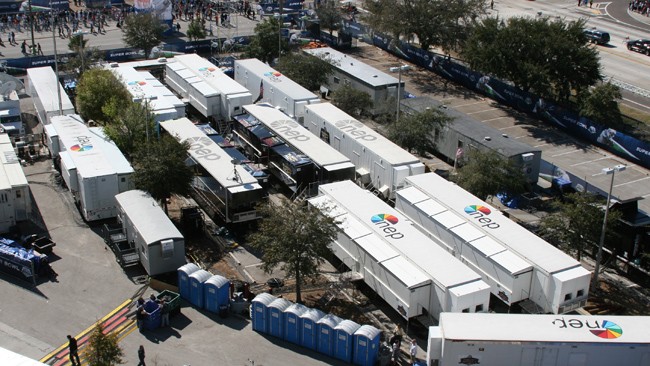HPA 2016: Remote Live Production

INDIAN WELLS, CALIF.—The name of the remote game is pressure—the pressure to make live event television coverage instantly accessible, more effectively, for less money with no particular pipeline of trained recruits. That was the upshot of remote production panel discussion at the HPA Tech Retreat this week.
NEP elected the economy-of-scale model, making acquisitions that give it a global television production footprint, including, most recently, Consolidated Media Industries in Hilversum, Netherlands. Hilverum is 17 miles southeast of Amsterdam, home of Dutch TV production giant, Endemol.
“There is pressure to do production effectively and cheaply,” said NEP chief technology officer, George Hoover. Infrastructure is part of that. NEP also has 100,000 miles of phone lines in the Netherlands and operates two data center content delivery networks.
“Unlike some other places, the data center is part of our package,” he said.
LIVE TV OVER IP
The network presence gave NEP the ideal opportunity to deploy IP-based remote production. With trucks, when they’re in use, they’re making money. When they’re parked, they’re not. IP technology held the promise of a more efficient architecture versus the truck fleet, if it could work for live TV production.
NEP CMI division, DutchView Infostrada, aired “Carlo’s TV Café” live on RTL4, last November, using remote-controlled cloud production using SMPTE-2022 over Grass Valley IP camera technology. (SMPTE-2022 is the standard for encapsulating video signals for IP transport.)
“The control room can be anyplace,” Hoover said. “We’ve been doing two or three shows a week. We’ll probably be doing three or four a day.”
Michael Harabin, vice president of technology, engineering and media management for Pac-12 said the collegiate sports network televises 850 live events every season, now over IP transport.
“The challenge was how to produce field hockey and lacrosse and rugby… and break even,” he said.
“We have partners in the 12 consortium, so all we did was fiber the network,” he said. “Our farthest campus is Salt Lake City. Latency was 24 milliseconds. Everything’s about latency, routing and who’s the best provider.”
Pac-12 Network now has no other products in the field. The networks uses JPEG2000 with Nevion encoders. Everything comes out of San Francisco, to master control in Denver, he said.
Down the road Harabin said Pac-12 is looking at virtualizing master control, because they see the cable business going away, and they like the idea of spinning up as many networks as they want. The would like to get to the point where master control operator can go to Starbucks and operate playout. He said they’re looking to move everything from capex to opex.
$K
Philip Garvin, president of Colorado Studios/Mobile TV Group, thought they might get ahead of the competition with 4K, so MTVG built a 4K mobile unit, assigned it to HD productions and slo-mo, and “keep waiting for someone to call and say, ‘we’d like to use that 4K truck,’” he said. Garvin estimated that making outfitting a remote unit for 4K production costs an extra $1 million to $2 million.
Garvin said the the same cameras that do 4K can also do super slo-mo.
“That’s been extremely helpful to us, so we can invest in these cameras and use them while we’re waiting for 4K,” he said. “You’re looking way, way in the future when you build a truck.”
Garvin said 4K is not so hard, but that 4K high-dynamic range is not so easy. There are implications for the entire workflow, he said. For now, MTVG is working to recoup its 4K investment, and it’s not a seller’s game.
“The only place to squeeze is the truck companies these days,” he said. “We have to use all the technologies to provide a better fan experience, for less. They’re not just looking for 5 percent or 10 percent, but ‘big cuts,’” he said.
Joe Wire of flypack supplier Bexel said that when executives look at their investment cycle, they ask, “what are people going to do to improve the fan experience at home? That’s been a challenge for us… When we look at our investment, it’s really around how we can use our equipment best. Sometimes, you get a long-term contract for your truck. Sometimes, you don’t. So, for example, what is the lifecycle of HDR? What is the business case?
“It’s a struggle,” he said, with lots of hedging around 4K.
Asked if high-dynamic range 4K would be as compelling as the transition from standard to high definition, Garvin said it wouldn’t be quite the same.
“When we started HD in 2001, there were about 50,000 homes with HD sets. They were very expensive. Today, there may be somewhere between 20 million and 30 million 4K sets—they’re not HDR—and that tips the scale. Many are software-upgradable to HDR,” he said.
PEOPLE
Another issue in the truck business is finding qualified crew members. Harabin said it’s a challenge to get people in San Francisco, where a guy turned them down because he couldn’t bring a dog to work.
“It’s not glamorous to work at a television station,” he said.
Hoover said you have to “grow your own. Nobody else makes them. Harvard doesn’t graduate 5,000 of them every year.”
Harabin lauded NEP’s training program and said PAC-12 is doing likewise. Interns work for NEP for two years, then they’re sent out on the road as a third engineer on a three-person truck crew. Hoover talked about the necessity to balance personalities on a truck crew.
“Typically, an OB truck will send two or three people,” he said. “So those two people pretty much live together 220 days a year—you find the right personality mix, and it takes time to do it—it benefits both of them.
“It doesn’t take long. We’ve replicated this thing so many times, it’s second nature.”
The professional video industry's #1 source for news, trends and product and tech information. Sign up below.
